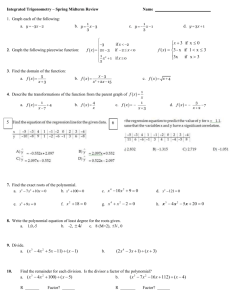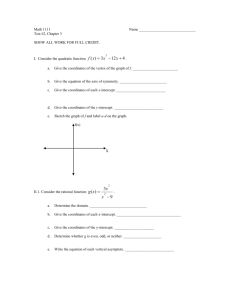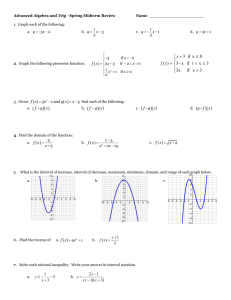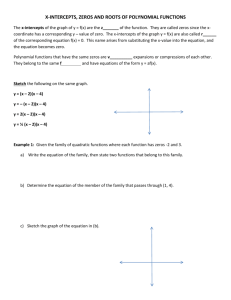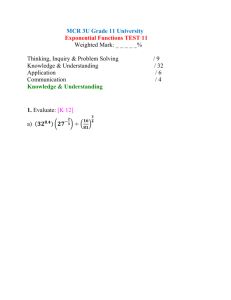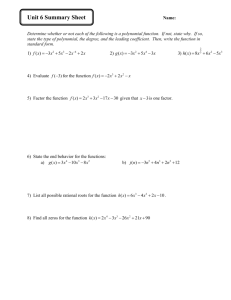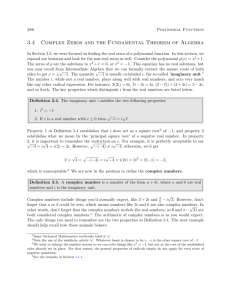Math 1111 Final Exam Review
advertisement
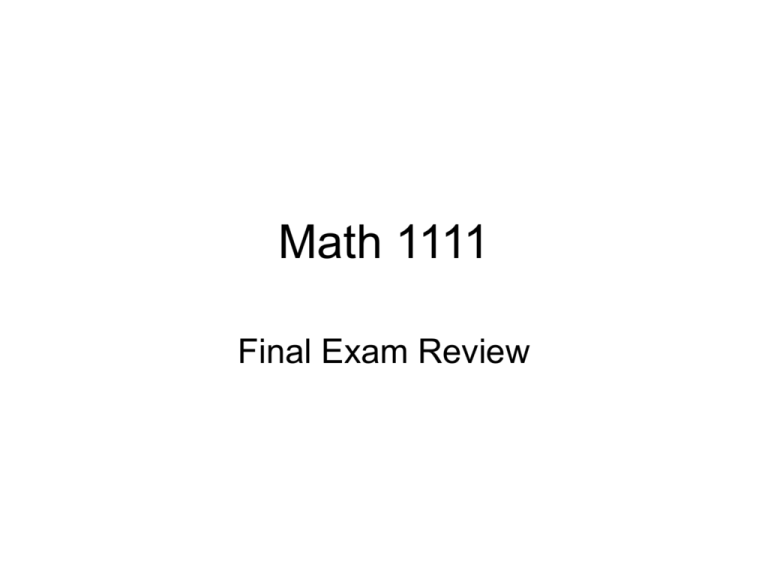
Math 1111
Final Exam Review
1. Identify the type of function.
f(x) = 5
6
4
Constant
2
-5
5
-2
2. Identify the type of function.
2
x
f ( x) 2
x 4
1
-2
Quotient of two
polynomials.
Rational
Function
2
-1
10
3. Identify the type of function.
8
6
f ( x) 2 x 7 x 15
3
-10
Highest
Exponent 3
4
2
-5
5
-2
-4
-6
-8
-10
Polynomial
Function
-12
-14
-16
-18
-20
-22
10
4. Identify the type of
function.
55
50
45
f ( x) 7 x 4 x 28
2
40
35
30
Highest
Exponent 2
25
20
15
Quadratic
Function
10
5
-10
10
5. Identify the type of function.
f ( x) 3
x 1
2
8
Variable in the
Exponent
Exponential
Function
6
4
2
-5
5
-2
6. Identify the type of function.
f ( x) x 3
6
4
Linear
2
-5
5
-2
7. $1500 is invested at a rate of 6¼%
compounded continuously. What is the
balance at the end of two years?
Continuous Compounding
• A = balance at the
end of investment
period
• P = Principal
(Money invested)
• r = rate = 0.0625
• t = time in years = 2
A Pe
( 0.0625)( 2 )
A 1500e
( 0.125)
A 1500e
A 1500(1.13315)
A 1699.725
$1699.73
rt
8. Evaluate the expression.
4.7e
3
• Round your answer
to 3 decimal places.
≈ 26.565
10. Evaluate the expression.
0.076t
300e
0.076(15)
300e
1.14
300e
≈ 95.95
• When t = 15.
• Round your answer
to 2 decimal places.
11. What transformations are
used to create the “child”?
Parent
f ( x) 2
Child
g ( x) 2 5
x
x
6
4
4
2
2
-5
5
1. Reflection of
x-axis.
-2
-5
2. Vertical shift
of 5 units.
5
-2
12. What transformations are
used to create the “child”?
Parent
f ( x) 2
Child
g ( x) 2
x
4x
1
6
6
4
4
2
2
-5
5
1. Reflection of
y-axis.
-2
2. Vertical shift
up of 1 unit.
3. Horizontal shift
right of 4 units.
5
13. $2100 is invested at a rate of 7%
compounded monthly. What is the balance
at the end of 10 years?
n Compoundings per year
r
A P 1
n
nt
12(10)
0.07
A 21001
12
120
A 21001.00583
A 21002.00966
• A = balance at the end
of investment period
• P = Principal (Money
invested)
• r = rate = 0.07
• n = number of periods
per year = 12
• t = number of years
$4220.29
15a. Given f(x) = x3 – 2x2 – 21x – 18
answer the following questions.
• What is the degree of the polynomial?
3
•
According to the Fundamental Theorem of Algebra, how many zeros will
this polynomial have?
3
•
Use Descartes’ Rule of Signs to determine the number of possible positive
real zeros.
1 possible positive zero, one sign variation
•
Use Descartes’ Rule of Signs to determine the number of possible negative
real zeros.
f(-x) = (-x)3 – 2(-x)2 -21(-x) – 18 = -x3 – 2x2 + 21x - 18
2 or 0 possible negative zeros, two sign variations
15b. Given f(x) = x3 – 2x2 – 21x – 18
answer the following questions.
• Use the Rational Root Test to list All
possible rational zeros of the polynomial.
p
q
• Where p is a factor of -18 and q is a factor
of 1
p
1; 2; 3; 6; 9; 18
q
Given all of these candidates, how can
you tell which is the actual root?
f(x) =
3
x
–
2
2x
– 21x – 18
p
1; 2; 3; 6; 9; 18
q
Synthetic Division
Graphing
calculator
15c. Given f(x) = x3 – 2x2 – 21x – 18
answer the following questions.
• Use the synthetic division to find all zeros
of the polynomial.
-1
1
1
-2
-21
-18
-1
3
18
-3
-18
0
( x (1))( x 3x 18)
2
( x 1)( x 3x 18)
( x 1)( x 6)( x 3)
2
x {3, 1, 6}
Each zero has a
multiplicity of one.
16a. Given f(x) = x4 + x3 – 11x2 + x – 12
answer the following questions.
• What is the degree of the polynomial?
4
•
According to the Fundamental Theorem of Algebra, how many zeros will
this polynomial have?
4
•
•
Use Descartes’ Rule of Signs to determine the number of possible positive
real zeros.
3 or 1 possible positive zero, three sign variations
Use Descartes’ Rule of Signs to determine the number of possible negative
real zeros.
f(-x) = (-x)4 + (-x)3 – 11(-x)2 + (-x) – 12
= x4 – x3 – 11x2 – x – 12
1 possible negative zero, one sign variation
16b. Given f(x) = x4 + x3 – 11x2 + x – 12
answer the following questions.
• Use the Rational Root Test to list All
possible rational zeros of the polynomial.
p
q
• Where p is a factor of -12 and q is a factor
of 1
p
1; 2; 3; 4; 6; 12
q
16c. Given f(x) = x4 + x3 – 11x2 + x – 12
answer the following questions.
3
1
1
1
-11
1
-12
3
12
3
12
4
1
4
0
( x 3)( x 4 x x 4) 0
by
( x 3)[ x 2 ( x 4) 1( x 4)] 0 Factor
grouping
( x 3)( x 4)( x 2 1) 0
x
{
4,
3,
i
,
i
}
2
Extract
( x 1) 0
the
2
Each zero has a
x 1
root.
multiplicity of one.
x 1 i
3
2
17a. Find and plot the y-intercept.
Write as an ordered pair.
x5
5
0
5
f ( x)
y
y
x3
3
03
Set x = 0
5
0,
3
y-intercept
17b. Find and plot the zeros. Write
as an ordered pair.
x5
f ( x)
x3
Set f(x) = y = 0
x5
0
x3
5, 0
x 5
17. Vertical Asymptote
(4, 9)
8
x 3 0
x3
x5
f ( x)
x3
6
4
5, 0
2
-5
5
-2
-4
-6
x=3
Set the denominator = 0
5
0,
3
-8
10
17. Horizontal Asymptote
an 1
y
bm 1
(4, 9)
8
x5
f ( x)
x3
6
4
y 1
5, 0
2
y=1
-5
-2
-4
5
0,
3
-6
x=3
Since the degree of the two
polynomials is the same find
the ratio of the leading
coefficient of the numerator
divided by the leading
coefficient of the denominator.
5
-8
10
17. Find function values to
help you graph.
1
f (6)
9
8
11
6,
3
4
2
y=1
-5
5, 0
5
1, 1
-2
5
0,
3
-4
-6
2, 7
-8
x=3
f (2) 7
f (4) 9
f (6) 11
3
4,9
x5
f ( x)
x3
6
f (1) 1
1
6,
9
(4, 9)
10
17. Find function values to
(4, 9)
help you graph.
4,9
8
x5
f ( x)
x3
6
11
6,
3
4
2
1
6,
9
y=1
-5
5, 0
5
1, 1
-2
5
0,
3
-4
-6
-8
x=3
2, 7
10
18a. Find and plot the y-intercept.
Write as an ordered pair.
x x2
f ( x)
x 3
2
0 02
y
03
Set x = 0
2
0,
3
y-intercept
2
2
y
3
18b. Find and plot the zeros. Write
as an ordered pairs.
x x2
x
x
2
f ( x)
0
x 3
x 3
2
2
0
x
x
2
Set f(x) = y = 0
0 ( x 2)( x 1)
x
{
2,
1}
2,
0
(1,0)
2
x x2
f ( x)
x 3
2
18. Vertical Asymptote
(4, 9)
8
x 3 0
6
x3
4
2
2, 0
2
0,
3
1, 0
-5
-2
-4
-6
x=3
Set the denominator = 0
-8
5
10
x x2
18. Horizontal Asymptote f ( x)
x 3
2
Since the degree of the numerator is
greater than the degree of the
denominator there is no horizontal
asymptote.
Slant Asymptote
y=x+4
22
18. Find function values to help you graph.
20
2
f (3)
3
1
f (1)
2
f (2) 4
18
16
14
12
10
6
f (4) 18
4
2, 0
-20
-15
-10
2
2
0,
3
1, 0
-5
5
-2
-4
-6
x=3
f (6) 13.3
x x2
f ( x)
x 3
2
8
10
15
20
19a. Find and plot the y-intercept.
Write as an ordered pair.
x
f ( x) 2
x 3x 4
0
y
2
(0) 3(0) 4
Set x = 0
(0,0)
y-intercept
0
y
4
19b. Find and plot the zeros. Write
as an ordered pairs.
x
f ( x) 2
x 3x 4
Set f(x) = y = 0
(0,0)
The Only Zero
0 x
x
19. Vertical Asymptote f ( x)
2
Set the denominator = 0
x 3x 4
2
0 x 3x 4
0 ( x 4)( x 1)
x {4, 1}
5
4
3
2
1
-6
-4
-2
2
(0,0)
-1
-2
-3
-5
x=1
x = -4
-4
4
19. Horizontal Asymptote
x
f ( x) 2
x 3x 4
Since the degree of the numerator is
less than the degree of the
denominator the horizontal asymptote
is y = 0.
x
f ( x) 2
x 3x 4
4
19. Find function
values to help you
graph.
3
2
1
-6
-4
-2
2
(0,0)
-2
-3
-5
x=1
-4
4
y=0
-1
x = -4
3
f (6)
7
3
f (3)
4
1
f (1)
6
1
f ( 2)
3
1
f ( 4)
6
5
20. Find the Domain:
2
x
f ( x)
x 1
x 1 0 x 1
{x | x , x 1}
21. Find the Domain:
4 x
f ( x) 2
x 10
x 10 0
2
x 10
x 10
2
{x | x , x 10}
22. Match the function with the graph:
8
7
A) f(x) = 4x – 5
6
5
B) f(x) = 4x + 5
4
3
C) f(x) = 4-x + 5
2
1
D) f(x) = 4-x – 5
-4
-2
2
-1
-2
4
6
23. Match the function with the graph:
8
7
A) f(x) = 3x-1
6
5
B) f(x) = 3x – 1
4
3
C) f(x) = 31- x
2
1
D) f(x) = 3-x – 1
-4
-2
2
-1
-2
4
6
24. Match the function with the graph:
8
7
A) f(x) = 5x+1 – 2
6
5
B) f(x) = 5x+2 – 1
4
3
C) f(x) = 5x-1+ 2
2
1
D) f(x) = 5x-2 + 1
-4
-2
2
-1
-2
4
